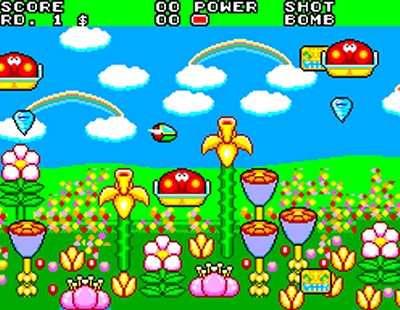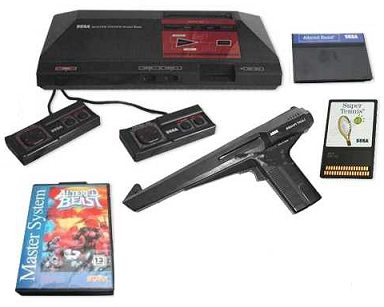Sega Master System 101: A Beginner’s Guide
Note from racketboy: Special thanks goes to Chrono for putting most of this guide together! The RetroGaming 101 series is aimed at gamers who are just starting out in the classic gaming scene or are curious about an older console that they don’t know much about yet.
Before Sega made wave with the Genesis/Megadrive in the 16-bit era, it had its first international console release with the Sega Master System. It didn’t have nearly the success in the US as the Nintendo Entertainment System, but it had large market share in Europe and Brazil and still has quite a following. We’ll try to cover all the basics about the Master System, but if you have any other tips or tidbits of info about this little machine, feel free to share it in the comments below.
Historical Impact
- The First version is the Mark III, which was only released in Japan (1985) and was basically an upgrade of the SG-1000 II, it looks similar and is backwards compatible with SG-1000 games.
- The Master System came out in 1986 in North America, EU and Japan in 1987
- Due to strong International support (mainly in European markets and in other regions like Brazil), the Master System is the second best selling Sega console with 13 million units sold, only the Mega Drive/Genesis sold more.
- The Master System enjoyed a decade of strong sales in Brazil and other smaller markets when Nintendo did not sell the NES.
- Their were no official mascots for the Master System, but Alex Kidd and Sonic are often thought of as being the unofficial mascots. (But Sonic showed up on the Genesis first)
- The Master System laid the technical groundwork for Sega’s portable Game Gear system.
- In the global market, the Master System was heavily overshadowed by the Nintendo Entertainment System (NES).
- While early consoles typically came bundled with a game cartridge (such as Mario/Duck Hunt on NES), the Master System had games embedded in the console hardware.
- The 3D Glasses were an ambitious accessory — especially for a first-party release. They worked well and were innovative.
Strengths
- Good 8-bit Color Palette: Better color palette than the NES, 64 colors to the 48 on the NES. The SMS had up to 32 simultaneous colors available (one 16-color palette for sprites or background, an additional 16-color palette for background only) from a palette of 64 (can also show 64 simultaneous colors using programming tricks)
- Some Excellent Ports: R-Type, Alex Kidd games, Ghouls and Ghosts, Sonic 1, 2 and Chaos, Shinobi, Phantasy Star, Fantasy Zone (if it doesn’t render you blind) are all great on the Master System. IThe SMS also has a better version of Castle of Illusion than on the Genesis/Mega Drive, even if it is very similar to Mario 2.
- Phantasy Star - It’s worth repeating that the original Phantasy Star (a wonderful RPG) is on the Master System. Will complement the three sequels on the Genesis quite nicely.
- 3D Glasses - An early example of Sega’s creativtiy in both hardware and software. It created a number of its games to support the 3D glasses accessory. They are rather hard to find, but worked surprisingly well.
- Strong Support in Brazil - Classic Sega systems are still quite popular in Brazil and the Master System received many games published well after the machine had died off elsewhere. Games included ports of Street Fighter 2 and Dynamite Headdy (from Treasure)
- Very Durable Console Hardware: The machine itself (Master System 2 mainly) holds up well to coffee spills, kickings and overplaying surprisingly well. I’ve broken a Master System 1, but I’ve had the same Master System since 1991.
- Play On the Genesis With Power Base Convertor: Even if you don’t have a Master System, but do own a Genesis/Megadrive you can play Master System games, just put a Master System Converter into the console and you’re set. The Genesis sound chip is actually the same processor as the Master System’s CPU, so everything runs perfectly.
- Master System and Genesis/Megadrive Controllers Interchangable: That’s right — Master System and Genesis controllers use the same connector and are backwards/forwards-compatible with each other. (and Atari joysticks too) So if you prefer Genesis controller or just have a bunch laying around, don’t worry about hunting down Master System controllers. You can also use Master System controllers with your Genesis/Power Base Converter combo for more authenticity Solid Game Boxes: The game boxes are of good quality, none of that cardboard NES, SNES and N64 stuff
- More Affordable in the UK - NES games are far more expensive in the UK than they are in America which is why the Master System is so much more attractive in that region.
Weaknesses
- Limited Game Library: The Master System had about 300 games compared to the NES’ 500+ classics.
- Most Multi-Platform Games are Inferior: Despite having a few excellent ports (see above), most games that showed up on both NES and SMS seem to be inferior.
- Low Quality Controllers - The D-pad on the standard controller feels unresponsive at times and breaks quite easily.
- Difficult to Find in the US: Both the consoles are hard to come by games in America compared to the NES or Genesis.
Hardware Variations
| Master System (Model 1) / Mark III |
| Master System II The Master System 2 was a cosmetic update that included some cost-saving technical changes as well. Cartridges are inserted under the black plastic lid that slid back to expose the cartridge port. (Unfortunately, after repeated use, the lid over the cartridge slot loses it’s elasticity and just hangs half over) The Master System II did not have an expansion port (which was never used anyway), card reader or reset button. All the cartridge games functioned properly on the SMS II, but because of the lack of a card port, the Sega Card games and the 3D Sega Scope Glasses were not usable on the SMS II. The Master System II also included Alex Kidd in Miracle World as the built-in game (1991 saw Sonic 1 built into some consoles) |
| Master System III (2003) In Brazil the Sega Master System is still alive and well, mainly due to the fact that many people can’t afford to guy a brand new XBox or PS2 and so settle for the cheaper Famiclones or SMS clones instead. Looks pretty much like the domestic SMS II (which was also released in Brazil.) Not so sure about the pastel color though. I believe this console has Alex Kidd in miracle world built in, but I could be wrong. Picture taken from the Tec Toy website, the official distributor of Sega products for Brazil and most of South America. |
| Master System 3 (2008) The Master System 3 (not to be confused with the Master System III (above) from 2003). The new console has a more modern design similar to the Genesis/Megadrive and comes with 131 built-in games (such as Sonic the Hedgehog, Alex Kidd and Golden Axe and a six-button controller. (However, none of the included games have been found to support the extra buttons). The main disadvantages are the lack of a cartridge slot and the relatively high price (about $125 USD) |
| Master System Compact / Girl Only released in Brazil, this rather innovative iteration was the wireless Master System Compact developed by Tec Toy. This little machine actually transmits the audio and video over an RF connection (similar to over-the-air TV). It was produced from 1994 to 1997 and is still a collector’s piece. A variation of this machines was the Master System Girl, was also released in an attempt to attract female consumers. The only difference in this version is a strong pink casing and pastel buttons. |
| Power Base Convertor Even though it isn’t a formal Master System console, I figured it should be included here since its a great way to play original Master System games. Serving as a simple pass-through device, it will let you play Master System games perfectly on your Sega Genesis/Megadrive. |
| Portable Master System The Master System hardware are re-purposed into a smaller handheld form factor in late 2006. It is 3 AAA batteries, has a brighter active matrix screen, and contained 20 Game Gear and Sega Master System games. It was released under several brands including Coleco and PlayPal. |
Game Library
- Games That Defined The Sega Master System - Many were direct competition to Nintendo’s biggest titles, but Sega did have some of it’s own personality in some areas.
- The Cheapest Sega Master System Games Worth Your Time - If you want to build your Master System cart collection quickly on a budget, take a look at this guide to get your the values.
- Much like the Genesis, the Master System had plenty of old-school sports to choose from. Games like World Class Leaderboard, Wimbledon, Super Kick Off and California Games are the front-runners (shockingly no Track and Field)
Accessing Built-In Games
- The games Hangon/Safari hunt were built into later models of the original Master System to replace an unnamed puzzle game that was originally included.
- Pressing up, 1, and 2 on Master Systems without Hangon/Safari Hunt would bring up snail maze
- Pressing 1 and 2 and THEN turning the master system on, on master systems with hangon/safari hunt on (ie not Master System 2 onwards).
AV Connections
- The Master System uses the same video cables as the Model 1 Sega Genesis.
Master System Accessories
While this isn’t an extensive list, here are the most popular accessories for the Master System. It’s also worth noting that Master System controllers use the standardized Atari-style 9-pin connector and can be connected without modification to all other machines compatible with that standard, including the Sega Genesis/Megadrive, Atari 2600, Commodore Amiga, Atari ST, Commodore 64, Amstrad CPC and ZX Spectrum with Kempston interface or similar.
| Standard Controller Very similar design to the NES controller. Early versions of the pad had a removable thumbscrew and the connector cable came from the right side of the pad. Sega later revised the pad and took away the thumbscrew option and placed the connector wire at the top of the pad where it should have been to begin with. One odd thing worth mentioning is that standard Master System controllers did not have a pause button. Other variations include a 6-button version that was released in Brazil and the SG Commander controller that was later released with built-in rapid fire. |
|
| Control Stick This was supposed to give more control for arcades classics like Afterburner and Outrun. For some strange reason, Sega put the buttons on the left side of the controller. Understandably, this threw everyone off. Even if you turned the controller upside down, the buttons were in the “wrong” order. |
|
| Handle Controller This controller for driving/flying games was only released in Europe. Supposedly, it broke easily. |
|
| Light Phaser The light phaser was like the NES zapper but heavier and far more responsive and accurate (no need to go and press on the screen). The styling was modeled after the Zillion gun from the anime series. And much like the NES Zapper, Sega was forced to issue orange guns so they would not be mistaken for real weapons. Tec-Toy also released a blue Light Phaser in Brazil. (The SMS Light Phaser is not backwards-compatible with Genesis/Megadrive light gun games) |
|
| Sports Pad Only released in the USA and Japan, this trackball controller was required by some games, such as Sports Pad Football and Great Ice Hockey and isn’t supported in most games. |
|
| 3D Glasses Unlike the red/blue paper 3D glasses these actually work. The glasses plug into the Master System Power base 3D glasses adapter then into the Master System’s card slot. Unfortunately very few titles make use of this accessory. Keep in mind, these only work with the original Master System and the Power Base Converter as they went into the card slot. |
|
| Genesis Controllers As mentioned above, you can also use Sega Genesis/Megadrive controllers on your Master System as well (and vice versa). The B and C buttons on the Genesis controllers correspond to 1 and 2 respectively and the other buttons (most notably Start) don’t do anything. |
.
Emulation
- Emulators are available from a variety of sources such as PC, Mac, Dreamcast, XBox, GP2X, Nintendo DS, PSP and more. Many of the Master System emulators are actually built into Sega Genesis emulators as the Master System CPU is actually the Genesis sound processor.
- If you would like to learn more about emulating the Sega Master System with Kega, check out this guide for setting up Kega Fusion on a Windows PC.
- You also have commericial emulation options like the Wii Virtual Console.
Importing
- Master System games are region free between the US and the UK
Affordability
- Many cheap games are available - They may be a bit harder to find in the US, but many of the most popular Master System games are quite common. Those that are rare in the US might be cheaper in the UK and can easily be imported.

Example of the 3d Glasses - (Probably the best accessory ever made for a console)!

Fantasy Zone 2

